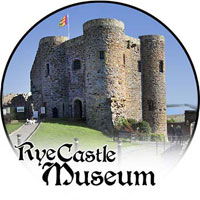Pre-Roman Times
Stone Age Times: Paleolithic, Mesolithic and Neolithic
By Jo Kirkham
The southeast coast received many tribes from the “continent” in pre- historic times. Between 10,000 and 7,000 BC Paleolithic (Old Stone Age) hunters walked across the land-link which existed where the English Channel now is; they left stone tools and hand axes as testimony.
During the Mesolithic (Middle Stone Age) period–7000-4000 BC– the ice sheets began to melt and there was serious flooding — forming the North Sea and English Channel.
Neolithic (New Stone Age) times, from about 4000 BC, saw different tribes come across the sea from what is now Northern France and Belgium. They brought a ‘revolution’ in life style, having developed farming as a way to live, as opposed to just surviving by hunting and gathering as had previous visitors.
There is evidence that from about 3000 BC two streams of culture met on the chalk downs of Sussex, one from the south-west, the ‘civilised’ Mediterranean world, which has been named Megalithic culture, and the other from the east, the outer edge of Neolithic Europe. The latter came in across ‘our’ coastline.
Subsequently individual peoples can be identified, for example the Beaker Folk (about 1900 BC), named for their special burials in beakers, and Wessex tribes (about 1600 BC), noted for their skills in designing and trading. A flint ‘factory’ has recently been discovered at Iden.
The Bronze Age is named for the times when the people had learned the skills of metal working – about 700 BC. Iron Age folk came in waves between 500 and 50 BC. Collectively they have become known as Celtic peoples. Britain entered the ‘full Iron Age’ in mid first century BC when the Belgae tribe came from the lower Rhineland.
In our area there was a vigorous and technically well advanced ironmaking industry in existence, based on the Wadhurst Clay Ridge, above Hastings, which had iron ore and timber for charcoal. Ingots were shipped out by small estuarine ports on the Brede and the Rother to other parts of the Belgic south-east — coastwise to the Chichester-Fishbourne area, or to Kent, and across the Channel to Gaul. Other items exported to mainland Europe from our area were hunting dogs and slaves. Our district, around the mouth of the Rother, was the border zone between the tribes of the Cantii (or Cantiaci) and the Atrebates.
Roman Times
Julius Caesar’s Visits
In 55 BC Julius Caesar left Boulogne for Britain as, he said,‘it would be a great advantage to have visited the island, to have seen what kind of people the inhabitants were, and to have learned something about the country with its harbours and landing places.’ He arrived at Dover, but faced with antagonistic tribesman, he sailed on and landed further north with the help of his friend and ally Commenius. Bad weather and the onset of winter forced him to return to Gaul, but he had more ships built and returned in the summer of 54 BC.
The probable result of these two visits was agreement between some tribes and Rome and these arrangements led to increased trade. Caesar records that there was iron production in the maritime region of Britain -– based on Wealden iron ore, timber for charcoal and clay for the kilns being available. There was a great impetus given to iron production during the years that followed these visits, before the Roman Invasion. Indeed, it has been suggested that the existence of this iron industry, and the wish to own and control it, was one of the main reasons for this Roman Invasion.
Roman Invasion and Ironworks
In 43 AD, the Romans began to bring the country completely under Roman control when the Emperor Claudius sent an army which landed at Richborough. The invasion army is described as being in three sections and it has been interpreted that these were divided between Richborough, Dover and Port Lemanis (facing what is now Romney Marsh). After the passage of the Legions further North and West, this region, the land of the Cantaci, with its capital at Canterbury, became a core area for Roman control of Britain.
The Wealden ironmaking areas were ‘nationalised’ by the Romans very soon after the invasion. According to the latest research, they made it an imperial estate, controlled by Classis Britannica (the Roman Fleet), for over 250 years. There is much evidence of Roman ironworks in many local villages, for example Brede/Broad Oak, Icklesham, Beckley, Peasmarsh….. At Beauport Park, outside Hastings, remains of a Roman bath-house built as part of an iron-making complex, have been discovered and excavated, although the settlement which must have accompanied it has not yet been found.
The products from these works were sent along several Roman roads, built on the ridges, which linked the works. (Part of one of these was excavated at Icklesham some years ago.) The iron was then exported from the ports on the Rother and Brede rivers and estuaries.
Roman Remains
The most impressive and visible remains of Roman occupation are the ruins of Stutfall Castle, Lympne, 3rd-4th century A.D. fortifications that guarded the coastal inlet which allowed access into the marsh and rivers draining the eastern Weald. The fort was a link in the chain of Saxon Shore forts constructed by the Romans along the English Channel to guard against increasingly frequent pirate raids by the Saxon group of tribes during the third century AD.
A list of 428 AD gives the names of 10 of these forts, and the system had been in place at least 100 years by then, under the command of the ‘Count of the Saxon Shore’. There is textual evidence that ‘Riduna,’ half way between Portus Lemanis (Port Lympne) and Anderida (Pevensey), may have been Rye.
Rome appears to have accepted that Britain was no longer part of the Roman Empire after c.410 AD.
